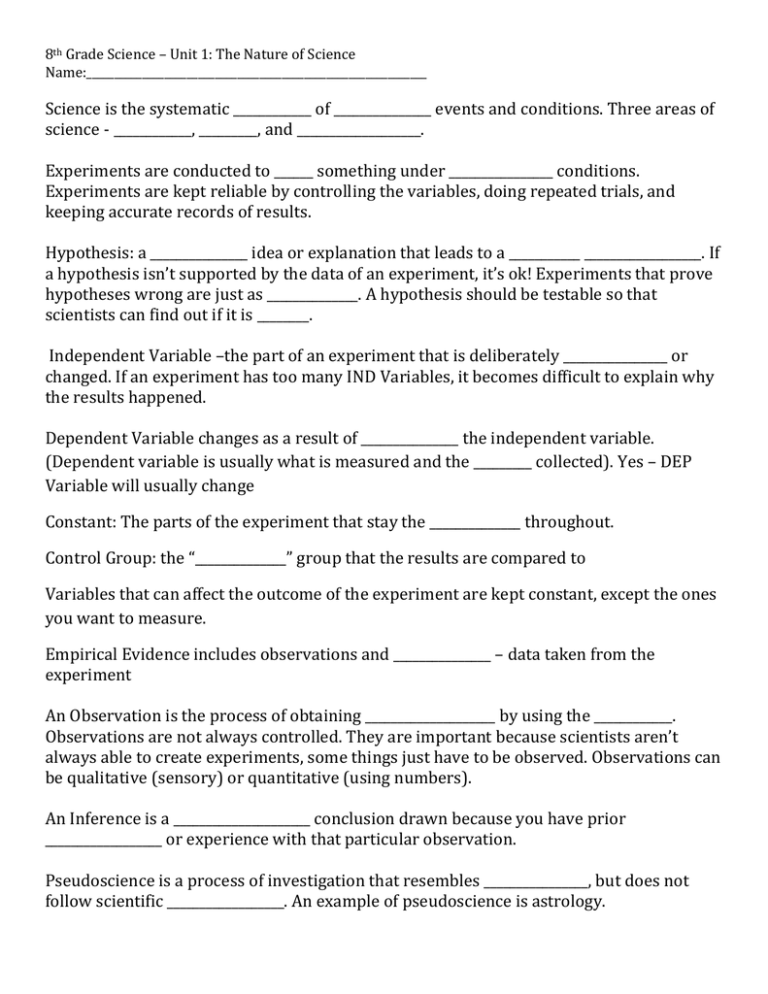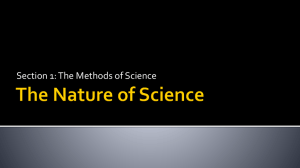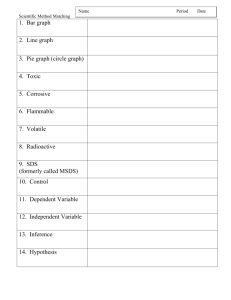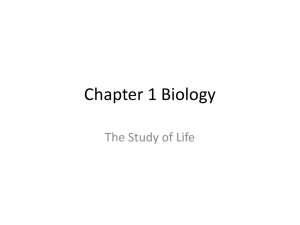8th Grade Science: Nature of Science Worksheet
advertisement

8th Grade Science – Unit 1: The Nature of Science Name:_____________________________________________________________ Science is the systematic ____________ of _______________ events and conditions. Three areas of science - ____________, _________, and ___________________. Experiments are conducted to ______ something under ________________ conditions. Experiments are kept reliable by controlling the variables, doing repeated trials, and keeping accurate records of results. Hypothesis: a _______________ idea or explanation that leads to a ___________ __________________. If a hypothesis isn’t supported by the data of an experiment, it’s ok! Experiments that prove hypotheses wrong are just as ______________. A hypothesis should be testable so that scientists can find out if it is ________. Independent Variable –the part of an experiment that is deliberately ________________ or changed. If an experiment has too many IND Variables, it becomes difficult to explain why the results happened. Dependent Variable changes as a result of _______________ the independent variable. (Dependent variable is usually what is measured and the _________ collected). Yes – DEP Variable will usually change Constant: The parts of the experiment that stay the ______________ throughout. Control Group: the “______________” group that the results are compared to Variables that can affect the outcome of the experiment are kept constant, except the ones you want to measure. Empirical Evidence includes observations and _______________ – data taken from the experiment An Observation is the process of obtaining ____________________ by using the ____________. Observations are not always controlled. They are important because scientists aren’t always able to create experiments, some things just have to be observed. Observations can be qualitative (sensory) or quantitative (using numbers). An Inference is a _____________________ conclusion drawn because you have prior __________________ or experience with that particular observation. Pseudoscience is a process of investigation that resembles ________________, but does not follow scientific __________________. An example of pseudoscience is astrology. The scientific method is a guideline. Not all experiments follow these steps identically and in the same way! Most importantly, science must test questions, have multiple trials, and must collect data under controlled situations. These are the most important aspects of reliable science! What happens if the data from your experiment does not match your hypothesis? Make a new one! Form a new hypothesis, plan a new experiment, and try again! Why is it important for scientists to be unbiased when investigating their theories? Why do scientists repeat trials during an experiment? When scientists obtain new information, what happens to an existing scientific theory? What must happen before a scientific explanation is widely accepted? Models help scientists explain certain phenomena. What makes a good model? This is a data table. Tables organize data into columns and rows. Year 1930 1940 1950 1960 1970 1980 1990 1999 2009 Average price of a new car $640 $850 $1,510 $2,600 $3,900 $7,210 $16,000 $21,100 $28,000 Scientists make graphs from data tables. Turn this data into a line graph: What conclusion can be made from this data? This is a bar graph. What was the increase in the number of female athletes from 2006 – 2007? The line graph below shows the average annual salary at a company over a nine-year period. How much greater was the average salary in 2007 than in 2008? This is a pie chart that shows how a city’s budget is allocated. If the city spends $200,000 on government operations, approximately how much does it spend on community development? The students in Mrs. Dhaibar’s science class take a test. The results of the test are shown in the table below. Grade A B C D F Percentage of students who earned this grade 25% 25% 35% 10% 5% Mrs. Dhaibar creates a pie chart to display this data. Which grade does the shaded region correspond to?





